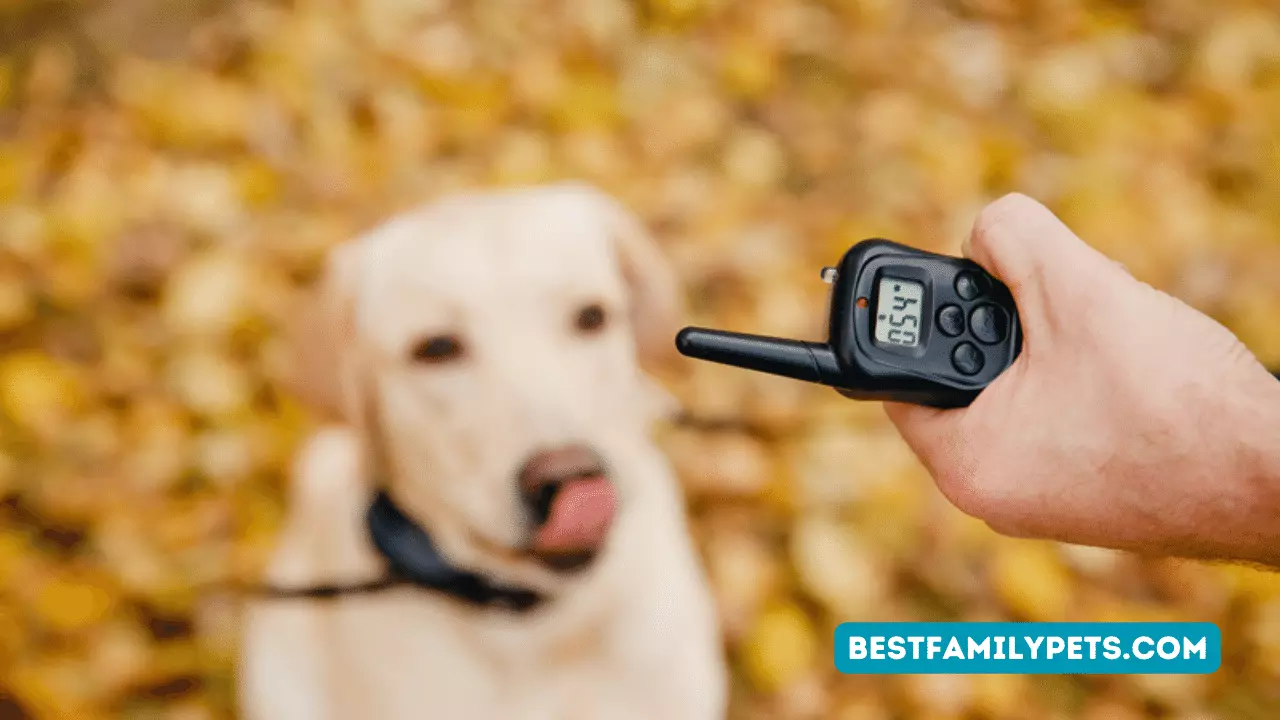Why Should You Refrain From Using Shock Collars?
Discover why refraining from shock collars is crucial. Prioritize your pet’s well-being and explore effective and humane alternatives.
Electronically controlled shock collars for dogs are currently legal in the U.S. and many other countries around the world. But what are shock collars? How do they work? Using a shock collar on your dog is comparable to using a stun gun on a human being. It’s painful, leads to severe physical and emotional damage, and does not teach your dog to be obedient nor make it understand what actions are leading to pain.
So, the question remains, are shock collars cruel? Yes, they might be in many cases. Here are some of the reasons for not using a shock collar to train your dog.
How Do Shock Collars Work?
Shock collars are primarily used to train dogs. The collar is made up of a transmitter and receiver, fitted on the dog’s neck. When the dog does something that is not desirable, the transmitter sends an electric shock to the receiver, which acts as a deterrent.
Pet owners who want their dogs obedient without the need for daily training sessions or verbal commands use shock collars.
Bousnic Dog Training Collar – 3300ft Range, Orange
The Bousnic Dog Training Collar in orange offers a humane and effective solution for correcting unwanted behaviors in dogs ranging from 5 to 120 lbs. This versatile e-collar features three adjustable training modes: an 8-level beep, a 16-level vibration, and a 99-level safe static shock. These varied correction options allow you to tailor the training to your dog’s temperament and sensitivity, helping even stubborn dogs become well-behaved companions. With its extended 3300ft (3/4 mile) range, this remote training collar provides ample freedom for your pet to explore while maintaining control, making it ideal for outdoor adventures and recall training.
Designed for convenience and durability, the Bousnic dog training collar supports dual-channel operation, allowing you to train two dogs simultaneously. The receiver boasts an IP67 waterproof rating, ensuring reliable performance in various weather conditions, though the remote control should be kept dry. A crucial safety feature is the instant-response on/off switch, preventing accidental corrections. Furthermore, both the receiver and remote offer impressive battery life; the receiver lasts up to 15 days, and the remote for over a month on a single charge. This long-lasting battery is a significant advantage for extended trips like camping or tailgating, ensuring your training tools are always ready when you need them.
Pros
- Three humane and adjustable training modes: beep, vibration, and safe shock.
- Extensive 3300ft (3/4 mile) remote range for greater freedom.
- Supports training for two dogs simultaneously with dual-channel functionality.
- Accommodates a wide range of dog sizes (5-120 lbs).
- IP67 waterproof receiver for all-weather use.
- Excellent battery life for both receiver and remote, ideal for travel.
- Instant-response security on/off switch prevents accidental corrections.
Cons
- Remote control is not waterproof.
- Requires responsible and ethical use of shock correction.
What Does the Study Suggest?
Research conducted by the University of Bristol found that shock collars can hurt the mental health of pets and their owners, leading to reduced activity levels, increased stress, and even accidents with the potential for injury.
This study suggests that there may be unintended consequences of using electronic training devices like shock collars. They should be used as the last resort when all other training methods have been unsuccessful.
Bousnic 3300ft Dog Training Collar for 2 Dogs
The Bousnic Dog Training Collar offers an advanced and effective solution for training up to two dogs simultaneously, suitable for pets weighing 5-120 lbs. With an impressive **3300ft (1100 yards) control range** and a reliable through-wall antenna, you can confidently train your furry friends indoors or in spacious backyards without any signal delay. This e-collar features three humane and adjustable training modes: **8 levels of beep, 16 levels of vibration, and 99 levels of safe static shock**. This versatility allows you to customize the correction intensity based on your dog’s temperament and training needs, helping to effectively curb undesirable behaviors.
Designed for convenience and durability, the Bousnic dog training collar boasts an **IP67 waterproof receiver**, ensuring your dog can enjoy swimming, showering, or stream-trekking without worry (though the remote should be kept dry). The receiver is also lightweight and compact, ensuring comfortable wear for all dog sizes. For enhanced safety and ease of use, the ergonomic remote features a **security lock** and separate buttons to prevent accidental shocks, alongside clear **dual-channel switching** to train two dogs simultaneously. With its quick 2-3 hour charge time, the collar provides an ultra-long battery life of 15-60 days, making it perfect for extended outdoor activities like camping or long runs. Remember to ensure a snug fit, allowing one to two fingers between the collar and your dog’s neck for comfort and effectiveness.
Pros
- Expansive 3300ft (1100 yards) range with through-wall signal capability.
- Three adjustable, humane training modes: beep, vibration, and safe shock.
- IP67 waterproof receiver, ideal for various water activities.
- Dual-channel remote for training two dogs at once.
- Security lock feature on remote prevents accidental corrections.
- Quick charge with impressive battery life (15-60 days).
- Suitable for a wide range of dog sizes (5-120 lbs).
Cons
- Charging adapter not included (requires a 5V phone charger or power bank).
- Remote is not waterproof.
- Requires careful fitting to prevent discomfort or chewing by the dog.
Downsides of Using Shock Collars

Shock Collars Can Cause Skin Burns
Some people claim that these collars are effective for training dogs because they work by giving the dog a small electric shock whenever he does not obey commands.
And the same people frown upon when asked the question – are shock collars cruel? But some studies have shown that not only do these shocks put pressure on your dog’s neck, but they also cause other problems such as burns on their skin.
They Can Make Pets More Aggressive
A shock collar has been associated with increased aggression in some dogs, which can be dangerous if owners are unaware of the side effects. Additionally, these collars have been known to malfunction and administer shocks at unintended times.
As a result, there have also been reports of injuries to humans if they contact the dog while wearing the collar. The use of shock collars may also make it difficult for children or others to approach an animal, as it can make them afraid.
Shock Collars Are Less Effective Than Humane Training
Shock collars are a topic of much debate and controversy in the pet industry. While some believe that shock collars are more effective than humane training methods, others believe that is not the case.
Shock collars are electric, and they emit a high voltage shock to the dog when they misbehave. A humane trainer uses rewards instead of punishments to teach the dog how to behave.
Don’t Work on Stubborn Pets
Shock collars must be avoided as they cause physical pain that is difficult to control. Additionally, they may not even work on particularly stubborn pets since they will simply ignore the painful stimuli. When you want to train your pet, the better method is to use positive reinforcement and not resort to harmful shock collars.
Stay Within the Law
The United States of America law states that shock collars should not be used as an automatic correction device; they should only be used with animal trainers. The law does not prohibit using these devices in certain situations, and it is up to you whether you would want to use them or not.
Green Dog Training Collar – 7 Modes, 2600ft Range
This **green dog training collar** offers a comprehensive solution for managing your pet’s behavior with **7 distinct training modes**. You can utilize **Beep, Vibration, Low Shock (0-50 levels), High Shock (51-99 levels), Shock Lock, Light, and Keypad Lock** modes to effectively teach basic commands and address challenging behaviors in small, medium, and large dogs. The **Shock Lock mode** provides convenience, allowing you to use only vibration and beep, while the distinct low and high shock ranges, coupled with the keypad lock, help you set precise and comfortable static levels for your dog, preventing accidental operations on the remote.
Designed for active dogs and various environments, the **receiver is 100% waterproof**, making it suitable for swimming, rainy conditions, and other outdoor activities (please note the remote is not waterproof). The collar strap is **adjustable from 8 to 26 inches**, fitting dogs weighing **8 to 140 lbs**. For the static shock function, it’s recommended for dogs over 20 pounds or older than 3 months. With **99 adjustable static levels**, you can fine-tune the intensity for your dog’s comfort and effectiveness. If your dog has long or thick fur, a slight trimming of the neck hair might be necessary to ensure proper contact and optimal function of the static correction.
Pros
- Features 7 versatile training modes for comprehensive behavior correction.
- Shock Lock and Keypad Lock modes enhance safety and prevent accidental shocks.
- 100% waterproof receiver is ideal for all weather and water activities.
- Adjustable collar fits a wide range of dog sizes (8-140 lbs).
- Offers 99 precise static levels for tailored training.
- 2600ft remote range provides ample freedom for training.
Cons
- Remote control is not waterproof.
- Shock function is only for dogs over 20 lbs or 3 months old.
- May require shaving neck hair for effective static correction on some dogs.
Final Words
So, “are shock collars cruel?” It is not an easy choice because it can be excruciating for the dog while learning. Using shock collars on animals is associated with a severe and inhumane form of punishment. If you have any questions about using shock collars, consult your veterinarian first before deciding about it.
Additional Resources
- ASPCA: https://www.aspca.org/pet-care/dog-care/common-dog-behavior-issues/barking – The ASPCA discusses the ethical concerns and potential dangers associated with shock collars, emphasizing the importance of positive reinforcement training methods.
- Humane Society: https://www.humanesociety.org/resources/dog-collars – The Humane Society provides insights into the controversy surrounding shock collars, highlighting potential risks and advocating for humane training alternatives.
- American Veterinary Society of Animal Behavior (AVSAB): https://avsab.org/positive-reinforcement-is-more-effective-at-training-dogs-than-an-electronic-collar-study-shows/ – AVSAB’s position statement on the use of punishment in animal behavior management, including shock collars, citing potential adverse effects on pets’ well-being and behavior.
- PETA: https://www.peta.org/living/animal-companions/caring-animal-companions/dogs/electric-fences-shock-collars/ – PETA’s perspective on shock collars, emphasizing the physical and psychological harm they can cause to animals, and advocating for positive reinforcement training methods.
- The Kennel Club: https://www.thekennelclub.org.uk/about-us/campaigns/electric-shock-collars/ – The Kennel Club campaigns against the use of shock collars, highlighting the importance of responsible training techniques that prioritize the welfare of dogs.
- International Association of Canine Professionals (IACP): https://www.theiacp.org/resources/law-enforcement-code-of-ethics – The IACP’s code of conduct emphasizes the use of positive reinforcement and humane training methods while discouraging the use of aversive tools like shock collars.
- RSPCA Australia: https://kb.rspca.org.au/knowledge-base/is-the-use-of-electronic-dog-collars-legal/ – RSPCA Australia outlines concerns associated with the use of electronic collars for dogs, including potential physical and psychological harm, as well as the need for more effective and humane training methods.
- The Bark: https://www.thewildest.com/dog-behavior/shock-collar-ban-new-york – The Bark magazine provides insights into the controversy surrounding shock collars, discussing their effectiveness, ethical implications, and potential risks to canine well-being.
- Victoria Stilwell Positively: https://positively.com/dog-training/positive-training/positive-reinforcement/ – Victoria Stilwell advocates for positive reinforcement training methods as an effective and humane alternative to aversive techniques like shock collars, promoting a better bond between dogs and their owners.
- ScienceDirect: https://www.sciencedirect.com/science/article/abs/pii/S016815910300248X – This scientific article discusses the potential welfare implications and behavioral effects of shock collar training on dogs, providing empirical evidence on the subject.





